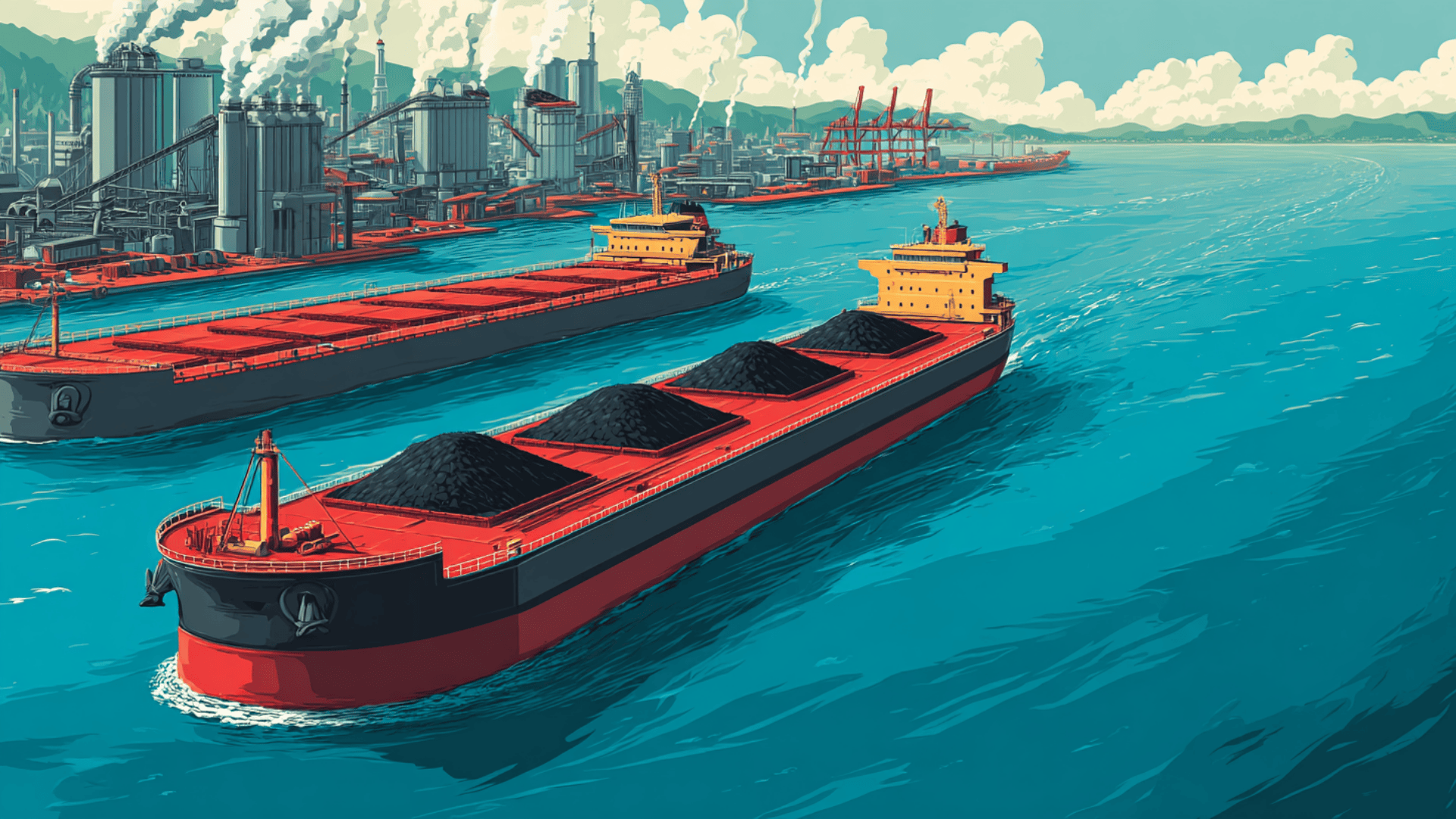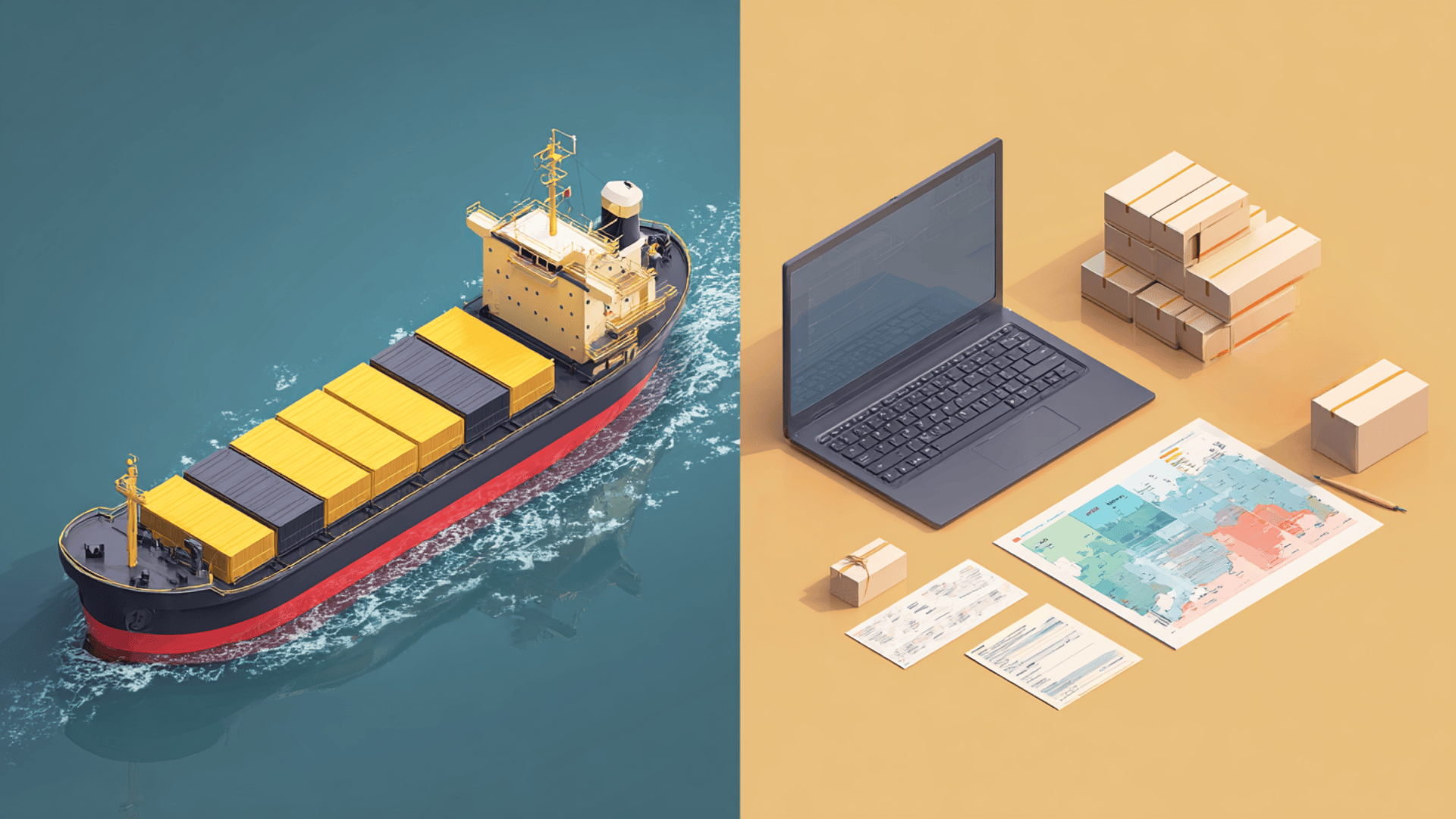Bulk shipping is a term that often causes confusion because it has two very different meanings.
In global trade, it refers to moving huge amounts of raw goods, like coal, oil, or grain, directly in ships built for that purpose. In e-commerce, it means processing and sending many small packages at once using batch tools and carrier discounts.
I’ve noticed that when people search for shipping advice, they sometimes mix these two ideas together. That’s why it’s important to clearly separate them.
Today, I’ll show you both sides and explain how each one works. Let’s start with the basics.
What is Bulk Shipping?
When people say “bulk shipping,” they can mean two very different things. One is about moving raw materials like coal or grain across the ocean. The other is about sending out many small packages at once for your business.
Commodity Bulk Shipping
This is the shipping you’ll see in global trade. Goods like coal, oil, or wheat are loaded straight into a ship’s hold without boxes or containers. These bulk shipments are measured by tons and often move through ports worldwide.
- Dry bulk: solid items such as grain, iron ore, or coal.
- Liquid bulk: fluids like oil or chemicals.
- Breakbulk: large items that don’t fit in containers, like heavy machinery.
E-commerce Bulk Shipping
This is about handling lots of customer orders at once. Instead of processing each package one by one, you upload order details in a single batch. Then the software prints all the labels at once, saving you time and reducing mistakes.
A quick side-by-side view makes it easier to see how the two types of bulk shipping differ.
| Aspect | Commodity Bulk Shipping | E-commerce Bulk Shipping |
|---|---|---|
| Goods | Raw materials (coal, grain, oil, ore) | Customer packages (small boxes, parcels) |
| Method | Loaded loose into ships or tankers | Orders uploaded and processed in batches |
| Scale | Huge volumes, measured in tons | Many small packages |
| Tools | Bulk carriers, tankers, specialized vessels | Shipping software, bulk label printing |
| Purpose | Support industries and global trade | Save time and cut costs for businesses |
Both approaches matter, but which one applies to you depends on whether you’re moving raw goods or customer orders.
Bulk Shipping in Global Trade

Bulk shipping is the backbone of global trade. It moves raw materials that keep industries like energy, construction, and manufacturing running. Without it, global supply chains would quickly break down.
1. Types of Bulk Cargo
There are three main kinds of bulk cargo. Dry bulk covers solid goods such as coal, grain, and iron ore. Liquid bulk includes fluids like crude oil, gas, or chemicals.
Breakbulk refers to large items that don’t fit in containers, such as heavy machinery or steel beams. Each type needs the right vessel and handling process to move safely.
2. How Bulk Carriers Work
Bulk carriers are ships built to handle these cargoes. Dry goods are poured straight into large cargo holds. Liquids are pumped into tanks. Breakbulk items are lifted by cranes and secured for transport.
The balance and storage of each load are managed carefully to keep the ship stable and prevent accidents at sea.
3. Industries Relying on Bulk Shipping
Many industries rely on bulk shipments every single day. Energy companies move coal, oil, and natural gas.
Farmers and food producers ship grains, fertilizers, and animal feed. Construction firms need steady supplies of iron ore, steel, and cement. Even the chemical industry depends on bulk shipping to get raw materials for manufacturing.
4. Major Providers
Two of the biggest names in this space are Star Bulk and CSL. Star Bulk operates one of the world’s largest fleets of dry bulk carriers, while CSL specializes in industrial dry bulk shipping and serves clients worldwide. These providers play a major role in keeping goods moving across oceans.
5. Costs and Pricing Factors
The cost of bulk shipping depends on several factors. Tonnage is one of the biggest drivers, since heavier loads cost more to move.
Routes also affect price, with port fees, distance, and shipping lanes all playing a role. Fuel costs are another key factor, and seasonal demand can push prices higher when space is limited.
Businesses often keep a close eye on these costs to plan their shipments more effectively.
Bulk Shipping in E-commerce

For small businesses, bulk shipping means sending out many customer orders at once instead of handling them one by one. It helps save time and money while keeping deliveries on schedule.
1. How Bulk Shipping Software Works
Most bulk shipping tools use software. You upload all your orders in a CSV file instead of entering them manually. The software then creates shipping labels for every package at once. Tracking is also combined, so you can check the status of all orders in one place.
2. Benefits for Small Businesses
Bulk shipments in e-commerce make order handling faster and more accurate. You spend less time creating labels, and carriers often give lower rates for bulk orders. Processing in batches also reduces errors since all the order data comes from one file.
3. Providers and Options
USPS offers bulk mailing discounts and online tools for businesses. FedEx has software for creating batch labels and gives small businesses discounts. DHL is useful for international bulk orders. Parcel Monkey helps compare rates and print labels through a single platform.
4. Costs and Discounts
Bulk shipping usually costs less per package than sending orders one by one. Carriers may lower rates if you ship a certain number of packages together. Some also offer flat-rate boxes for heavier parcels or online-only discounts when labels are printed through their systems
Bulk Shipping Costs Explained
The cost of bulk shipping depends on what you’re sending and how much of it needs to move. Commodities and e-commerce shipments follow very different pricing rules, but both are shaped by volume, distance, and added fees.
Commodity rates are usually priced by tonnage. Coal, grains, and oil are shipped in such massive amounts that even a small change in port fees or fuel costs can shift the total bill by thousands of dollars.
Example: A 10,000-ton coal shipment across the Atlantic may cost $12–$15 per ton. Once fuel and port charges are added, the final bill could reach $120,000–$150,000.
E-commerce bulk rates work in a completely different way. Here, carriers like USPS, FedEx, and DHL reward businesses for shipping in volume. The more packages you send, the lower the price per box. A seller processing hundreds of orders at once saves both money and time by batching them together.
Example: A business sending 500 packages might pay around $6 each with USPS. With FedEx or DHL volume discounts, that price could drop to $4–$5 per package.
Hidden costs play a big part too. Packaging supplies add up fast, especially when you’re handling large volumes. Handling fees at warehouses or ports can raise your final bill. And if your shipments cross borders, customs duties and taxes can’t be ignored.
Tip: Always plan for extras like packaging, handling, and customs. Forgetting them makes the “cheap” rate look far more expensive later.
In the end, both commodity shippers and small businesses have to look past the base rate. The real price comes from the full picture of tonnage, routes, discounts, and all the hidden add-ons that come with moving goods in bulk.
Bulk Shipping vs. Other Shipping Methods
Different shipping methods serve different needs. Bulk shipping works well for some goods, but containers, parcels, and breakbulk all have their own advantages
| Method | Best For | How It Works | Key Points |
|---|---|---|---|
| Bulk Shipping | Raw materials like coal, oil, or grain | Goods are loaded loose into ship holds or tanks | Extremely efficient for massive volumes, but limited to one type of cargo and offers less protection. |
| Container Shipping | Packaged goods or mixed cargo | Goods packed into large metal containers | Provides flexibility and protection, but less efficient for raw bulk materials. |
| Standard Parcel Shipping | Small orders, low volumes | Each package sent individually | Simple and widely available, but costly and time-consuming at higher volumes. |
| E-commerce Bulk Shipping | Many small packages at once | Orders processed in one batch with software | Saves time and reduces costs, though only valuable for businesses with steady shipping volume. |
| Breakbulk Shipping | Oversized or heavy cargo | Items loaded piece by piece and secured | Handles large, awkward loads, but slower and more expensive than other methods. |
Bulk shipping is best when the goal is efficiency with huge amounts of raw goods. Containers, parcels, and breakbulk fill in the gaps for packaged, small-scale, or oversized cargo.
How to Choose the Right Bulk Shipping Method
Choosing the right shipping method starts with knowing what you’re moving.
A company sending raw materials across oceans has very different needs than a small business handling customer orders.
The first step is to separate your situation.
If you’re shipping coal, oil, grain, or other raw goods, bulk carriers or breakbulk shipping will likely be the best fit. If you’re a business owner with many small packages, then e-commerce bulk shipping or parcel services are where you should look.
Beyond the type of goods, there are a few key factors that help narrow down the right choice.
Volume matters because large loads benefit from bulk carriers, while smaller loads may be cheaper in containers or parcels.
Cost is always critical, but it often ties directly to speed and distance. Some routes are more affordable but slower, while others cost more for faster delivery.
Destination also plays a big role; international shipping may involve customs and extra handling, while domestic routes can be simpler.
Here’s a quick checklist you can use to guide your decision:
- What type of goods am I shipping, raw materials or customer orders?
- How much volume do I need to move?
- What’s my budget, and where can I save on costs?
- How quickly does the shipment need to arrive?
- Am I shipping domestically or internationally?
- Are there customs, handling, or packaging requirements to plan for?
Working through these questions gives you a clearer picture of which bulk shipping method makes sense. It also helps you avoid paying for more capacity or speed than you really need.
Wrapping Up
Bulk shipping plays a huge role in both global trade and small business growth.
Whether it’s moving coal across oceans or sending hundreds of packages to customers, the right method depends on your needs, budget, and destination.
I’ve found that looking beyond base rates to include hidden costs makes planning much smoother. You’ll also save time by choosing the option that truly fits your volume.
If you want to keep learning about smarter ways to ship, manage costs, and grow your business, check out my other blogs for more helpful tips and guides.















